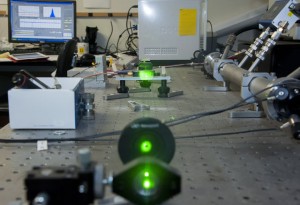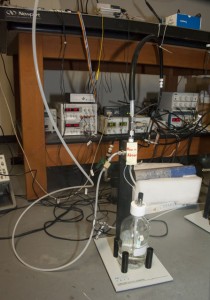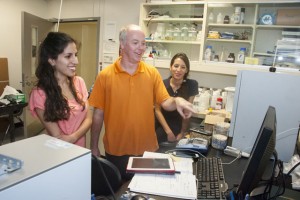CSUN Atmospheric Chemistry Prof Highlights Effects of Sea Spray, Brown Carbon on the Atmosphere
What is in the air surrounding the Earth? What makes city smog brown, or beaches cloudy? Or importantly, what impact do these substances have on global climate change?
At California State University, Northridge, atmospheric chemistry professor Daniel Curtis and six undergraduate students are exploring how sea spray, smoke and smog can affect the Earth’s atmosphere.
“These particles are called aerosols, and they can scatter or absorb light,” Curtis said. “So, when sunlight comes into the Earth’s atmosphere, if it is scattered, it can go back out into space, cooling the atmosphere. If it is absorbed, it warms the atmosphere.”
Curtis and his students have found that sea spray scatters light and causes a major cooling effect on the atmosphere around it. The team simulated and measured the phenomenon in a custom-built machine called a cavity ringdown spectrometer (CRS).

The cavity ringdown spectrometer was custom built by atmospheric chemistry professor Daniel Curtis. Comprised of a green laser which bounces between two mirrors inside a metal canister, it measures the refractive index of aerosol particles. Photo by Luis Garcia.
The CRS simulates atmosphere movement for particles, Curtis explained. By having two mirrors and a green laser that bounces back and forth between them, the CRS can reenact about 10 kilometers of distance that would be in the atmosphere.
Sea spray samples from Ventura, Manhattan, Huntington and Santa Barbara beaches were used as the different aerosols. Each sample was individually tested and put in a perfume spray-like bottle. A hose took the particles from the bottle and dried them in a silica gel canister. Next, the particles were measured out and dispersed based on nanometer size into a separate hollow canister, containing the two mirrors where the green laser, simulating the color of sunlight, bounced back and forth to detect how quickly light passed through the aerosol.
If the light moved quicker through the particles than through the chamber when it was empty, then the effect of the aerosol was interpreted as cooling the atmosphere. If the light moved slower through the particles because it was absorbed, then the effect of the aerosol was interpreted as heating the atmosphere. This is the case for certain aerosols called brown carbon, Curtis said.

Sea spray samples from Ventura Beach are placed in an aerosol bottle, pictured, then put through a silica gel drying chamber before entering the cavity ringdown spectrometer chamber. Photo by Luis Garcia.
In 2014, Curtis published a study in the science journal Atmospheric Environment, titled “Size and Mass Distributions of Ground-Level Sub-Micrometer Biomass Burning Aerosol From Small Wildfires,” focusing on the effects of small, local wildfires in the San Fernando Valley. The smoke from the fires is considered a type of brown carbon.
“If fires occur in locations where ozone concentrations are already relatively high, air quality [standards] can be violated,” the article said.
“Recent studies indicated that wildfire frequency, duration and fire season length have increased in the western United States due to climate change and are expected to continue to change in the future.”
The San Fernando Valley is a highly populated area, with more than 1.7 million residents, Curtis noted.
“Even small wildfires can impact human health if they occur close to urban areas,” Curtis said. “Large wildfires, even in rural areas, can affect air quality almost around the world.”
The wildfire study raises a big question in understanding global warming, he said.
“We know that humans are increasing greenhouse gases, and we know that warms the earth up,” he said. “What we don’t fully understand is the effects of these particles, so [sea spray] may be counteracting the greenhouse effect, or if [the particles] are dark, they might contribute even more [to warming the atmosphere].”
What makes brown carbon such an important aspect of atmospheric science is its complexity, Curtis said.
“We don’t fully understand what this stuff is. That’s why it’s lumped together as brown carbon,” he said. “We understand greenhouse gases really well. But we still don’t understand how the [brown carbon] aerosols work. We know the gases from fossil fuel combustion, but not the actual particles.
“One aspect that we are interested in is how sea-spray aerosol changes once it gets into the atmosphere with smog,” Curtis added. “We would like to find out what difference this might make on the climate effects of sea-spray aerosol.”

Left to right, senior chemistry student Farnaz Aghabarari, atmospheric chemistry professor Daniel Curtis, and senior chemistry student Maryam Ghiassee oversee the results of a sea spray aerosol test. Photo by Luis Garcia.
Senior chemistry majors Maryam Ghiassee and Farnaz Aghabarari, said the lab work they are doing with sea spray is life-changing, not just in terms of understanding climate change, but also in what they wish to do with their futures.
“I never thought I could do research [as an undergraduate],” Aghabarari said. “This is helping me see if I can be a researcher. I can understand the environment around me. When I go to the beach, [I am aware] that something is happening around me.”
Ghiassee, who said she wants to become an atmospheric chemist like Curtis, said that her lab experience has refocused her future plans.
“I don’t think I would have acknowledged this is what I want to do without the experience in the lab,” she said. “It would have been a hard transition into graduate school. I’m glad I actually like the work!”
Curtis said it is important to have undergraduate students involved in research, since it inspires them and exposes them to the big questions in atmospheric chemistry.
“At CSUN, undergrads get a chance to work on cutting-edge research,” he said. “That’s what we pride ourselves on. This is an actual analytical chemistry lab. They ask me questions that I don’t know the answer to, and that is real science.”


 experience
experience